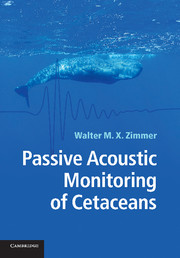Book contents
- Frontmatter
- Contents
- Acknowledgements
- Introduction
- Part I Underwater acoustics (the basics)
- Part II Signal processing (designing the tools)
- Part III Passive acoustic monitoring (putting it all together)
- 7 Applications of passive acoustic monitoring
- 8 Detection functions
- 9 Simulating sampling strategies
- 10 PAM systems
- References and further reading
- Index
10 - PAM systems
Published online by Cambridge University Press: 26 April 2011
- Frontmatter
- Contents
- Acknowledgements
- Introduction
- Part I Underwater acoustics (the basics)
- Part II Signal processing (designing the tools)
- Part III Passive acoustic monitoring (putting it all together)
- 7 Applications of passive acoustic monitoring
- 8 Detection functions
- 9 Simulating sampling strategies
- 10 PAM systems
- References and further reading
- Index
Summary
The last chapter of this book addresses some aspects of the PAM system that are fundamental in any PAM implementation. PAM systems are in general composed of hardware and very often also of software, so this chapter will first address the hardware and in particular describe and discuss hydrophones and their integration into a properly functioning PAM system.
Hardware
As humans are terrestrial mammals and not very well adapted to listening to underwater sound, they must rely on technical tools, or hardware, to implement passive underwater acoustic systems. All PAM systems are generally composed of hydrophones, support electronics and some sort of human interface.
Hydrophones
The purpose of a classical hydrophone is to convert (transduce) sound pressure into electrical tension or voltage. Consequently, piezoelectric materials are suitable materials for the construction of hydrophones. Piezoelectricity describes the property of some materials to produce an electric potential when mechanical stress is applied or external pressure changes the shape. Equivalently, piezoelectric materials change their form when an electric field is applied. Such an effect is used to generate sound in a transmitter.
Hydrophones in their simplest and most common form are designed to respond directly to the pressure of an incident sound wave. Hydrophones may, however, be constructed to respond to some aspect of the particle motion, such as displacement, velocity or acceleration. Hydrophones may further be designed to respond to the pressure gradient or acoustic intensity.
- Type
- Chapter
- Information
- Passive Acoustic Monitoring of Cetaceans , pp. 299 - 325Publisher: Cambridge University PressPrint publication year: 2011



